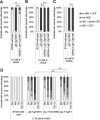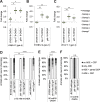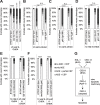Mutations in Caenorhabditis elegans neuroligin-like glit-1, the apoptosis pathway and the calcium chaperone crt-1 increase dopaminergic neurodegeneration after 6-OHDA treatment
- PMID: 29346364
- PMCID: PMC5773152
- DOI: 10.1371/journal.pgen.1007106
Mutations in Caenorhabditis elegans neuroligin-like glit-1, the apoptosis pathway and the calcium chaperone crt-1 increase dopaminergic neurodegeneration after 6-OHDA treatment
Abstract
The loss of dopaminergic neurons is a hallmark of Parkinson's disease, the aetiology of which is associated with increased levels of oxidative stress. We used C. elegans to screen for genes that protect dopaminergic neurons against oxidative stress and isolated glit-1 (gliotactin (Drosophila neuroligin-like) homologue). Loss of the C. elegans neuroligin-like glit-1 causes increased dopaminergic neurodegeneration after treatment with 6-hydroxydopamine (6-OHDA), an oxidative-stress inducing drug that is specifically taken up into dopaminergic neurons. Furthermore, glit-1 mutants exhibit increased sensitivity to oxidative stress induced by H2O2 and paraquat. We provide evidence that GLIT-1 acts in the same genetic pathway as the previously identified tetraspanin TSP-17. After exposure to 6-OHDA and paraquat, glit-1 and tsp-17 mutants show almost identical, non-additive hypersensitivity phenotypes and exhibit highly increased induction of oxidative stress reporters. TSP-17 and GLIT-1 are both expressed in dopaminergic neurons. In addition, the neuroligin-like GLIT-1 is expressed in pharynx, intestine and several unidentified cells in the head. GLIT-1 is homologous, but not orthologous to neuroligins, transmembrane proteins required for the function of synapses. The Drosophila GLIT-1 homologue Gliotactin in contrast is required for epithelial junction formation. We report that GLIT-1 likely acts in multiple tissues to protect against 6-OHDA, and that the epithelial barrier of C. elegans glit-1 mutants does not appear to be compromised. We further describe that hyperactivation of the SKN-1 oxidative stress response pathway alleviates 6-OHDA-induced neurodegeneration. In addition, we find that mutations in the canonical apoptosis pathway and the calcium chaperone crt-1 cause increased 6-OHDA-induced dopaminergic neuron loss. In summary, we report that the neuroligin-like GLIT-1, the canonical apoptosis pathway and the calreticulin CRT-1 are required to prevent 6-OHDA-induced dopaminergic neurodegeneration.
Conflict of interest statement
The authors have declared that no competing interests exist.
Figures








Similar articles
-
6-OHDA-induced dopaminergic neurodegeneration in Caenorhabditis elegans is promoted by the engulfment pathway and inhibited by the transthyretin-related protein TTR-33.PLoS Genet. 2018 Jan 18;14(1):e1007125. doi: 10.1371/journal.pgen.1007125. eCollection 2018 Jan. PLoS Genet. 2018. PMID: 29346382 Free PMC article.
-
Tetraspanin (TSP-17) protects dopaminergic neurons against 6-OHDA-induced neurodegeneration in C. elegans.PLoS Genet. 2014 Dec 4;10(12):e1004767. doi: 10.1371/journal.pgen.1004767. eCollection 2014 Dec. PLoS Genet. 2014. PMID: 25474638 Free PMC article.
-
Dysregulated LRRK2 signaling in response to endoplasmic reticulum stress leads to dopaminergic neuron degeneration in C. elegans.PLoS One. 2011;6(8):e22354. doi: 10.1371/journal.pone.0022354. Epub 2011 Aug 3. PLoS One. 2011. PMID: 21857923 Free PMC article.
-
Caenorhabditis elegans as an experimental tool for the study of complex neurological diseases: Parkinson's disease, Alzheimer's disease and autism spectrum disorder.Invert Neurosci. 2011 Dec;11(2):73-83. doi: 10.1007/s10158-011-0126-1. Epub 2011 Nov 8. Invert Neurosci. 2011. PMID: 22068627 Review.
-
The Caenorhabditis elegans dopaminergic system: opportunities for insights into dopamine transport and neurodegeneration.Annu Rev Pharmacol Toxicol. 2003;43:521-44. doi: 10.1146/annurev.pharmtox.43.100901.135934. Epub 2002 Jan 10. Annu Rev Pharmacol Toxicol. 2003. PMID: 12415122 Review.
Cited by
-
Neurotoxin-Induced Animal Models of Parkinson Disease: Pathogenic Mechanism and Assessment.ASN Neuro. 2018 Jan-Dec;10:1759091418777438. doi: 10.1177/1759091418777438. ASN Neuro. 2018. PMID: 29809058 Free PMC article.
-
6-hydroxydopamine (6-OHDA) Oxidative Stress Assay for Observing Dopaminergic Neuron Loss in Caenorhabditis elegans.Bio Protoc. 2018 Sep 20;8(18):e3025. doi: 10.21769/BioProtoc.3025. Bio Protoc. 2018. PMID: 30406156 Free PMC article.
-
Exploring Caenorhabditis elegans as Parkinson's Disease Model: Neurotoxins and Genetic Implications.Neurotox Res. 2024 Feb 6;42(1):11. doi: 10.1007/s12640-024-00686-3. Neurotox Res. 2024. PMID: 38319410 Review.
-
Nanostars Carrying Multifunctional Neurotrophic Dendrimers Protect Neurons in Preclinical In Vitro Models of Neurodegenerative Disorders.ACS Appl Mater Interfaces. 2022 Oct 26;14(42):47445-47460. doi: 10.1021/acsami.2c14220. Epub 2022 Oct 11. ACS Appl Mater Interfaces. 2022. PMID: 36218307 Free PMC article.
-
Genetic and cellular sensitivity of Caenorhabditis elegans to the chemotherapeutic agent cisplatin.Dis Model Mech. 2018 Jun 21;11(6):dmm033506. doi: 10.1242/dmm.033506. Dis Model Mech. 2018. PMID: 29752286 Free PMC article.
References
-
- Schultz W. Multiple dopamine functions at different time courses. Annu Rev Neurosci. 2007;30: 259–88. doi: 10.1146/annurev.neuro.28.061604.135722 - DOI - PubMed
-
- Delamarre A, Meissner WG. Epidemiology, environmental risk factors and genetics of Parkinson’s disease. Presse Med. Elsevier Masson SAS; 2017;46: 175–181. doi: 10.1016/j.lpm.2017.01.001 - DOI - PubMed
-
- Thomas B, Beal MF. Parkinson’s disease. Hum Mol Genet. 2007;16: 183–194. doi: 10.1093/hmg/ddm159 - DOI - PubMed
-
- Klein C, Westenberger A. Genetics of Parkinson’s disease. Cold Spring Harb Perspect Med. 2012;2: a008888 doi: 10.1101/cshperspect.a008888 - DOI - PMC - PubMed
-
- Sies H, Berndt C, Jones DP. Oxidative stress. Annu Rev Biochem. 2017; doi: 10.1016/j.bpobgyn.2010.10.016 - DOI - PubMed
Publication types
MeSH terms
Substances
Grants and funding
LinkOut - more resources
Full Text Sources
Other Literature Sources
Molecular Biology Databases
Research Materials
Miscellaneous

